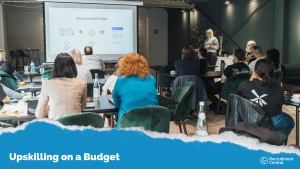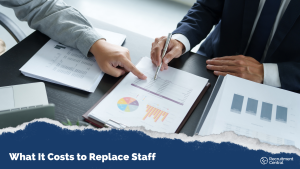How do you know if a new hire will thrive in your team and stay for the long haul? Assessing candidate fit and motivation helps you uncover more than just skills on a resume. This guide shares 12 practical interview questions that reveal how someone works, what drives them, and whether they’ll genuinely fit your culture – saving you time, money, and turnover in the long run.
Often, a candidate who looks fantastic on paper appears in your hiring pool. They have all the credentials you’ve been looking for, maybe they’ve even done the job before, and their references check out. Everything seems to line up until they start.
Then, within a few weeks, something feels off. The energy isn’t there. They seem distracted or unprepared. Sometimes they even clash with other team members. By the end of the quarter, they’re gone.
It’s frustrating when someone who seemed perfect on paper just doesn’t click once they’re in the role.
What You’ll Learn
- 12 strategic interview questions organised into four categories – job fit, cultural alignment, motivational drivers, and long-term commitment – that reveal whether candidates will thrive in your role beyond day one
- Why 66% of HR executives cite retention as their biggest challenge in 2025, and how asking the right questions during interviews can prevent costly early turnover before it starts
- How to assess three critical dimensions of fit – technical capability, cultural compatibility, and motivational alignment – that determine whether new hires stay engaged or disengage within months
- Practical question frameworks that move beyond credentials to uncover what truly motivates candidates, how they work best, and whether your role can deliver what they need to succeed
This happens more often than most people admit and costs more than just time. Team trust suffers, momentum stalls, and your hiring strategy resets to square one.
Lately, the issue has become even more common. In 2025, 66% of HR executives say retention is still their biggest challenge. Companies can’t solve this problem with intuition alone. A strong CV won’t tell you what motivates someone or how they really think. You need to ask the right questions.
Understanding Fit and Motivation in Hiring
When a hire doesn’t work out, you’ll often hear that the job just wasn’t the right “fit.” Sometimes employees realise quickly they can’t mesh with the culture. Others spend months trying to make it work. Either way, you end up with a gap in your team.
Poor fit can mean different things. Sometimes the problem is the job itself. A person might have the experience and ability to do the work technically, but they struggle with your processes or need more direction than you can provide.
Other times it’s the culture. Around 74% of employees feel demotivated by poor cultural fit. They can’t connect well with their team or manager, so they start to disengage. Conflict replaces collaboration.
Another issue, often the hardest to see and most impactful, is motivational fit. It’s about what keeps someone going, what they care about, and what they need from work to feel it matters. That might be purpose, learning, stability, creativity, recognition, or room to grow. If that piece is missing, the rest won’t hold.
That’s usually what “fit” means. Three things, more or less:
- Are they set up to do the work well?
- Can they work well with the people around them?
- Do they actually want to be here?
Most of us don’t always ask those questions directly, it’s easier to focus on skills and experience. But if those pillars of fit aren’t in place, everything else falls through.
The Top Questions for Assessing Candidate Fit and Motivation
The easiest way to solve the fit problem before it starts is to ask the right questions. You can group them into four categories: job fit, cultural fit, motivational drivers, and long-term alignment.
Category 1: Job Fit Assessment Questions
Sometimes the mismatch shows up straight away. The person starts strong, but a few weeks in, things slow down. They’re doing the work, but it’s not clicking. Or they’re asking questions that suggest they pictured something different. You notice it in how they talk about their day, how they don’t quite settle into the rhythm.
That’s a job fit issue. It’s not a question of capability, but of alignment, whether the way someone works suits what the role needs.
Some people want variety, others want depth. Some thrive with structure, while others prefer to build their own way of working. Most roles can’t offer all of that.
Here are the questions that help bring job fit into focus:
- “Describe your ideal work environment and the conditions that help you be most productive.”
- “Walk me through a typical day or week in your current role. What parts of it energise you most?”
- “Tell me about a time you had to adapt your work style to meet changing requirements.”
These questions reveal how someone works best, where their energy goes, and how they respond to change, all key indicators of whether they’ll thrive in your environment.
Category 2: Cultural Fit Assessment Questions
Some people join a team and naturally fall into step. The conversations flow, the pace feels familiar, and they connect easily. Others struggle to find their rhythm. You can sense hesitation or tension early on.
That’s cultural fit. It’s not about whether someone’s right or wrong for the job, it’s about how they like to work compared with how your team actually operates.
You can’t see this mismatch on a resume, but you can surface it with these questions:
- “Tell me about a work environment where you felt you belonged.”
- “How do you like to receive feedback?”
- “Think of a time you disagreed with your team. What did you do?”
These questions uncover how candidates relate to others, process feedback, and navigate differences, all essential parts of a healthy team culture.
Category 3: Motivational Drivers Questions
Most people want to do good work. The challenge is understanding what makes that work feel worthwhile for them.
Motivation isn’t just energy, it’s direction. It’s what pulls someone toward a certain kind of work or team. If that alignment is off, everything starts to drag. Tasks take longer, feedback can start to feel heavier than it should, and progress feels slower than it needs to be.
Here are three questions that define motivation:
- “What parts of your work have felt most fulfilling?”
- “Tell me about a project you’re proud of. What made it meaningful?”
- “What would make you leave a role within the first six months?”
These questions reveal personal values, priorities, and dealbreakers. They show what makes work meaningful for a person, and whether your role offers that.
Category 4: Long-Term Alignment Questions
It’s one thing for someone to be a good fit today, but another for that fit to last.
Sometimes the shift happens quickly. They take the role as a stepping stone or reset, and by six months, they’re restless. Other times it takes longer, a year in, the spark fades because the growth or variety they expected hasn’t arrived.
Long-term fit depends on how well a role matches what someone is genuinely looking for. These questions help you see that early:
- “Where do you see your work going in the next few years?”
- “What kind of manager brings out your best work?”
- “If you were in this role a year from now, what would tell you it’s been a good fit?”
These questions surface expectations, preferred support styles, and future goals. They help both sides see whether the opportunity aligns beyond the first few months.
Hiring for More Than Day One
A good interview can’t predict everything. People change, teams evolve, and roles shift. But the clearer you are about the work, the team, and what the person in front of you really wants, the better your chance of making a hire that holds.
These twelve questions won’t fix every challenge. What they can do is give you a language, a way to slow down, look past the surface, and talk about what makes work feel meaningful and what makes it last.
That’s how you build teams that last.
That’s where the real value lies. Not just in who can do the job, but in those who care enough to keep doing it, even when the work gets hard.
Looking for extra support to improve your recruitment and hiring process?
Explore our Employer Resources Hub for hiring strategies, templates and proven best practices.
You can also get refreshed with our guide Guide to Hiring Employees Made Easy, then stay ahead by subscribing for monthly insights, industry data and recruitment trends here.
For further leadership and organisational development support, visit this page.



















